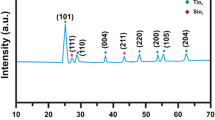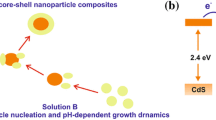Abstract
Laser ablation technique has be used to synthesize cadmium oxide and tin CdO(1-x)Snx nanocomposites. The XRD characteristics of the sample revealed the crystalline phase and cubic structure of the CdO samples, whereas the CdO: Sn nanocomposites with the doping ratios of (5, 10, and 15%) showed good crystallinity with cubic and tendency to orthorhombic structures. The crystallite size found to be slightly increasing with the doping ratio and the obtained values range from 26 to 30 nm. The average diameter is also increasing with the doping and ranges from less than 80 nm to about 90 nm. AFM analysis showed that increasing Sn-doping ratio causes a drop of the average roughness to a minimum value of about 0.5 nm and then increases with the doping to nearly similar case of undoped CdO sample. Optical measurements of absorption, transmission, and reflection spectra exhibit plasmonic effect and show significant effect of Sn-doping on the level and peak position of all the spectra. The energy band-gap value is enhanced with the doping and reach its maximum value of 2.722 eV at 10% doping ratio. On the other hand, the electron concentration, carrier mobility, and resistivity showed significant enhancement with the doping ratio. The dielectric properties have also shown remarkable variations with noticeable shifts in the peak values toward the higher wavelength range. The characteristic bands of both pure CdO and Sn-doped nanocomposites were confirmed by Fourier transform infrared spectroscopy (FTIR). All analyses suggest that the Sn-doping ratio of 10% is the optimum ratio for enhanced effects of these nanocomposites.
















Similar content being viewed by others
Data availability
Data will be available from the corresponding author upon reasonable request.
References
D. Ginley, C. Bright, Transparent conducting oxides. MRS Bull. 25(8), 15–18 (2000). https://doi.org/10.1557/mrs2000.256
H.B. Lee, W.-Y. Jin, M.M. Ovhal, N. Kumar, J.-W. Kang, Flexible transparent conducting electrodes based on metal meshes for organic optoelectronic device applications: a review. J. Mater. Chem. 7, 1087–1110 (2019). https://doi.org/10.1039/C8TC04423F
D.Y. Kang, B.-H. Kim, T.H. Lee, J.W. Shim, S. Kim, H.-J. Sung, K.J. Chang, T.G. Kim, Dopant-tunable ultrathin transparent conductive oxides for efficient energy conversion devices. Nano-micro Lett. 13, 211 (2021). https://doi.org/10.1007/s40820-021-00735-y
B. Raj, A. Raman, Nanoscale semiconductors: materials, devices and circuits. Taylor & Francis Group (2022). https://doi.org/10.1201/9781003311379
Y. Hong et al., Size dependent optical properties of LaB6 nanoparticles enhanced by localized surface plasmon resonance. J. Rare Earths 31, 1096–1101 (2013). https://doi.org/10.1016/s1002-0721(12)60410-4
O. Bitton, S. Gupta, G. Haran, Quantum dot plasmonics: from weak to strong coupling. Nanophotonics. 8, 559–575 (2019). https://doi.org/10.1515/nanoph-2018-0218
B. Raj, A. Raman, Nanoscale Semiconductors, 1st edn. (CRC Press, Boca Raton, 2022)
P. Velusamy et al., Incorporation of Ti3+ metal ions in chemically spray deposited CdO thin films for optoelectronic and chem-resistive based formaldehyde gas sensor applications. New J. Chem. 46, 22469–22485 (2022). https://doi.org/10.1039/D2NJ02925A
A. Kathalingam, K. Kesavan, A.U.H.S. Rana, J. Jeon, H.S. Kim, Analysis of Sn concentration effect on morphological, optical, electrical and photonic properties of spray-coated Sn-doped CdO thin films. Coatings 8(5), 167 (2018). https://doi.org/10.3390/coatings8050167
M. Thirumoorthi, J.T.J. Prakash, A study of Tin doping effects on physical properties of CdO thin films prepared by sol–gel spin coating method. J. Asian Ceramic Soc. 4, 39–45 (2016). https://doi.org/10.1016/j.jascer.2015.11.001
K. Sirohi, S. Kumar, V. Singh et al., Synthesis and characterization of CdO–SnO2 nanocomposites prepared by hydrothermal method. Acta Metall. Sin. 31, 254–262 (2018). https://doi.org/10.1007/s40195-017-0659-3
B. Ates, S. Koytepe, A. Ulu, C. Gurses, V.K. Thakur, Chemistry, structures, and advanced applications of nanocomposites from Bio-renewable resources. Chem. Rev. 120, 9304–9362 (2020). https://doi.org/10.1021/acs.chemrev.9b00553
A.A. Ziabari, F.E. Ghodsi, Optoelectronic studies of sol–gel derived nanostructured CdO–ZnO composite films. J. Alloys Compd. 509, 8748–8755 (2011). https://doi.org/10.1016/j.jallcom.2011.06.050
R.M. Mohamed, Z.I. Zaki, Degradation of Imazapyr herbicide using visible light-active CdO–TiO2 heterojunction photocatalyst. J. Environ. Chem. Eng. 9, 104732 (2021). https://doi.org/10.1016/j.jece.2020.104732
A.S. Kamble, N.S. Harale, P.S. Patil, B.B. Sinha, K.C. Chung, CdO and CdO-ZnO composite nanowires: Synthesis, characterization, and ethanol gas response, 2012 1st Int. Symp. Phys. Tech/ Sens. (ISPTS-1) (2012). https://doi.org/10.1109/ispts.2012.6260948
S.J. Helen, S. Devadason, T. Mahalingam, Improved physical properties of spray pyrolysed Al:CdO nanocrystalline thin films. J. Mater. Sci.: Mater. Electron. 27, 4426–4432 (2016). https://doi.org/10.1007/s10854-016-4313-z
M. Thambidurai, N. Muthukumarasamy, A. Ranjitha, D. Velauthapillai, Structural and optical properties of Ga-doped CdO nanocrystalline thin films. Superlattices Microstruct. 86, 559–563 (2015). https://doi.org/10.1016/j.spmi.2015.08.020
K. Usharani, A.R. Balu, V.S. Nagarethinam, M. Suganya, Characteristic analysis on the physical properties of nanostructured Mg-doped CdO thin films—doping concentration effect. Prog Nat Sci.: Mater. Int. 25, 251–257 (2015). https://doi.org/10.1016/j.pnsc.2015.06.003
K. Usharani, N. Manjula, A. Balu, V. Nagarethinam, Characteristic analysis of nanostructured Cl-doped CdO thin films– doping effect. Mater. Res. Innov. (2016). https://doi.org/10.1179/1433075x15y.0000000045
G.T. Chavan et al., Chemical synthesis of Cd1−x−yZnxCuySzSe1−z composite thin films for photoelectrochemical solar cell. Appl. Surf. Sci. 574, 151581 (2022). https://doi.org/10.1016/j.apsusc.2021.151581
R.O. Yathisha, Y. Arthoba Nayaka, P. Manjunatha, M.M. Vinay, H.T. Purushothama, Doping, structural, optical, and electrical properties of Ni2 doped CdO nanoparticles prepared by microwave combustion route. Microchem. J. (2019). https://doi.org/10.1016/j.microc.2018.10.060
S. Leelavati, P. Bhardwaj, Transition Metal (Mn, Ni) Co-doped CdO nanoparticles: demonstration of structural, optical, and magnetic properties. J. Supercond Nov. Magn. 35, 1575–1585 (2022). https://doi.org/10.1007/s10948-022-06272-y
M. Anitha, N. Anitha, K. Saravanakumar, I. Kulandaisamy, L. Amalraj, Effect of Zn doping on structural, morphological, optical, and electrical properties of nebulized spray-deposited CdO thin films. Appl. Phys. A: Mater. Sci. Process. (2018). https://doi.org/10.1007/s00339-018-1993-7
C. Uthiram, N. Punithavelan, Efficient magnetic and antibacterial properties of CdO/ZnO nanocomposites prepared via facile hydrothermal method. J. King Saud Uni.-Science. 34, 102162 (2022). https://doi.org/10.1016/j.jksus.2022.102162
A. Badawi et al., Tailoring the optical properties of CdO nanostructures via barium doping for optical windows applications. Phys. Lett. A 411, 127553 (2021). https://doi.org/10.1016/j.physleta.2021.127553
A. Akouibaa, R. Masrour, A. Jabar, G. Kadim, M. Benhamou, A. Derouiche, Numerical investigation of electronic, dielectric, and optical properties of CdO, SnO2/CdO and SnO2/CdO/PVP nanocomposites. Opt. Quantum Electron. (2021). https://doi.org/10.1007/s11082-021-03305-z
S. Kose, F. Atay, V. Bilgin, I. Akyuz, Some physical properties of CdO thin films used as window material in photovoltaic solar cells. Int. J. Green Energy 1, 353–364 (2004). https://doi.org/10.1081/ge-200033655
C. Ristoscu, I.N. Mihailescu, Thin films and nanoparticles by pulsed laser deposition: wetting, adherence, and nanostructuring. Pulsed Laser Ablation. (2018). https://doi.org/10.1201/9781315185231-7
M. Yan, M. Lane, C.R. Kannewurf, R.P.H. Chang, Highly conductive epitaxial CdO thin films prepared by pulsed laser deposition. Appl. Phys. Lett. 78, 2342–2344 (2001). https://doi.org/10.1063/1.1365410
E. Li, H. Zhuo, H. He, N. Wang, T. Liu, Structural, optical, and electrical properties of low-concentration Ga-doped CdO thin films by pulsed laser deposition. J. Mater. Sci. 51, 7179–7185 (2016). https://doi.org/10.1007/s10853-016-9998-0
K. Karthik et al., Multifunctional properties of CdO nanostructures Synthesized through microwave assisted hydrothermal method. Mater. Res. Innov. (2018). https://doi.org/10.1080/14328917.2018.1475443
C. Uthiram, N. Punithavelan, Efficient magnetic and antibacterial properties of CdO/ZnO nanocomposites prepared via facile hydrothermal method. J King Saud Univ. Sci. 34(6), 102162 (2022). https://doi.org/10.1016/j.jksus.2022.102162
R.K. Gupta, K. Ghosh, R. Patel, S.R. Mishra, P.K. Kahol, Preparation and characterization of highly conducting and transparent Al doped CdO thin films by pulsed laser deposition. Curr. Appl. Phys. 9, 673–677 (2009). https://doi.org/10.1016/j.cap.2008.06.004
T.A. Gessert, J. Burst, X. Li, M. Scott, T.J. Coutts, Advantages of transparent conducting oxide thin films with controlled permittivity for thin film photovoltaic solar cells. Thin Solid Films 519, 7146–7148 (2011). https://doi.org/10.1016/j.tsf.2011.01.143
V. Grivickas, J. Linnros, Carrier lifetime: free carrier absorption, photoconductivity, and photoluminescence. Charact Mater. (2012). https://doi.org/10.1002/0471266965.com037.pub2
A.M. Elkorashy, Optical constants of tin selenide single crystals in the transparency region. J. de Physique III(1), 1169–1179 (1991). https://doi.org/10.1051/jp3:1991178
D.A. Cristaldi, A. Gulino et al., Structural, electronic, and electrical properties of an undoped n-type CdO thin film with high electron concentration. J. Phys. Chem. C. 118, 15019–15026 (2014). https://doi.org/10.1021/jp5040085
F.P. Koffyberg, Electron concentration and mobility in semimetallic CdO. Can. J. Phys. 49, 435–440 (1971). https://doi.org/10.1139/p71-055
P. Umadevi, N. Prithivikumaran, Electrical parameters of metal doped n-CdO/p-Si heterojunction diodes. Physica B 501, 123–128 (2016). https://doi.org/10.1016/j.physb.2016.08.002
S. Maiti, K. Maiti, M.T. Curnan, K. Kim, K.-J. Noh, J.W. Han, Engineering electrocatalyst nanosurfaces to enrich the activity by inducing lattice strain. Energy Environ. Sci. 14, 3717–3756 (2021). https://doi.org/10.1039/D1EE00074H
K. Usharani, A.R. Balu, Structural, optical, and electrical properties of Zn-doped CdO thin films fabricated by a simplified spray pyrolysis technique. Acta Metall. Sin. 28, 64–71 (2015). https://doi.org/10.1007/s40195-014-0168-6
M. Anitha, K. Saravanakumar, N. Anitha, L. Amalraj, Influence of fluorine doped CdO thin films by an simplified spray pyrolysis technique using nebulizer. Opt. Quant. Elect. (2019). https://doi.org/10.1007/s11082-019-1901-1
A. Taylor, The study of carbon by the Debye-Scherrer method. J. Sci. Instrum. 18, 90–94 (1941). https://doi.org/10.1088/0950-7671/18/5/306
S. Fatimah, R. Ragadhita, D.F. Al Husaeni, A.B.D. Nandiyanto, How to calculate crystallite size from X-ray diffraction (XRD) using Scherrer method. ASEAN J. Sci. Eng. 2, 65–76 (2021). https://doi.org/10.17509/ajse.v2i1.37647
P. Jayaram, P.P. Pradyumnan, S.Z. Karazhanov, Micro-strain, dislocation density and surface chemical state analysis of multication thin films. Physica B Condens. Matter. 501, 140–145 (2016). https://doi.org/10.1016/j.physb.2016.08.018
J. Singh, Optical properties of materials and their applications (John Wiley, Hoboken, 2020). https://doi.org/10.1002/9781119506003
G.A. Evingür, Ö. Pekcan, Optical energy band gap of PAAm-GO composites. Compos. Struct. 183, 212–215 (2018). https://doi.org/10.1016/j.compstruct.2017.02.058
S. Gaponenko, H. Demir, Quantum confinement effects in semiconductors, in Applied Nanophotonics (ch3/ quantum confinement in semiconductors). (Cambridge University Press, Cambridge, 2018)
R.K. Gupta, M. Cavas, F. Yakuphanoglu, Structural and optical properties of nanostructure CdZnO films. Spectrochim. Acta A Mol. Biomol. Spectrosc. 95, 107–113 (2012). https://doi.org/10.1016/j.saa.2012.04.012
G.T. Chavan et al., Chemical synthesis of Cd1-x-yZnxCuySzSe1-z composite thin films for photoelectrochemical solar cell’. Appl. Surf. Sci. 574, 151581 (2022). https://doi.org/10.1016/j.apsusc.2021.151581
Funding
No funding was received for this work.
Author information
Authors and Affiliations
Corresponding author
Ethics declarations
Competing interest
The authors have no relevant financial or non-financial interests to disclose.
Additional information
Publisher's Note
Springer Nature remains neutral with regard to jurisdictional claims in published maps and institutional affiliations.
Rights and permissions
Springer Nature or its licensor (e.g. a society or other partner) holds exclusive rights to this article under a publishing agreement with the author(s) or other rightsholder(s); author self-archiving of the accepted manuscript version of this article is solely governed by the terms of such publishing agreement and applicable law.
About this article
Cite this article
Fadhali, M.M. Structural, optical, and electrical characterization of laser ablated CdO1-xSnx nanocomposites. J Mater Sci: Mater Electron 34, 1382 (2023). https://doi.org/10.1007/s10854-023-10762-7
Received:
Accepted:
Published:
DOI: https://doi.org/10.1007/s10854-023-10762-7




